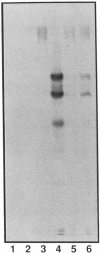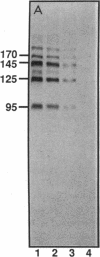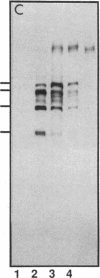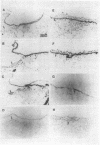Abstract
Epiligrin, the major component of human keratinocyte extracellular matrix, serves as the preferred integrin ligand for alpha 3 beta 1 in plasma membranes and focal adhesions, and colocalizes with alpha 6 beta 4 in hemidesmosomes. In human skin, epiligrin is found in the lamina lucida subregion of epidermal basement membrane, where it is thought to be associated with anchoring filaments. We have identified three patients with an acquired mucosal predominant subepidermal blistering disease who have IgG anti-basement membrane autoantibodies that bind the lamina lucida/lamina densa interface of epidermal basement membrane, stain cultured human keratinocyte extracellular matrix, and immunoprecipitate disulfide linked polypeptides of 170, 145, 125, and 95 kD in human keratinocyte culture media in a pattern identical to that of P1E1, a murine monoclonal antiepiligrin antibody. Comparative immunoprecipitation studies of patient sera, P1E1, and GB3 monoclonal antibody show that epiligrin is identical to the antigen (i.e., BM600 or GB3 antigen) previously reported to be absent from the skin of patients with lethal junctional epidermolysis bullosa, an inherited subepidermal blistering disease. Moreover, skin from a fetus with this disease shows no evidence of reactivity to patient antiepiligrin autoantibodies or P1E1. These studies show that antiepiligrin autoantibodies are a specific marker for a novel autoimmune blistering disease and that the epidermal basement membrane antigen absent in patients with lethal junctional epidermolysis bullosa is epiligrin.
Full text
PDF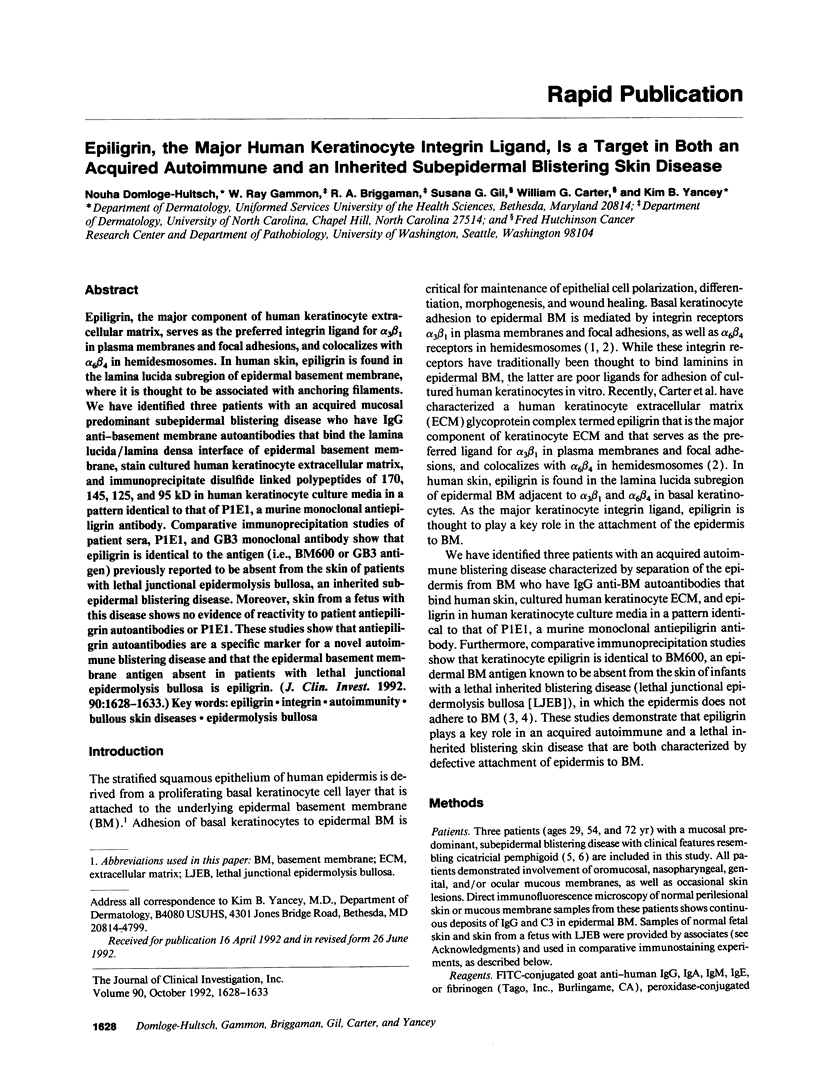
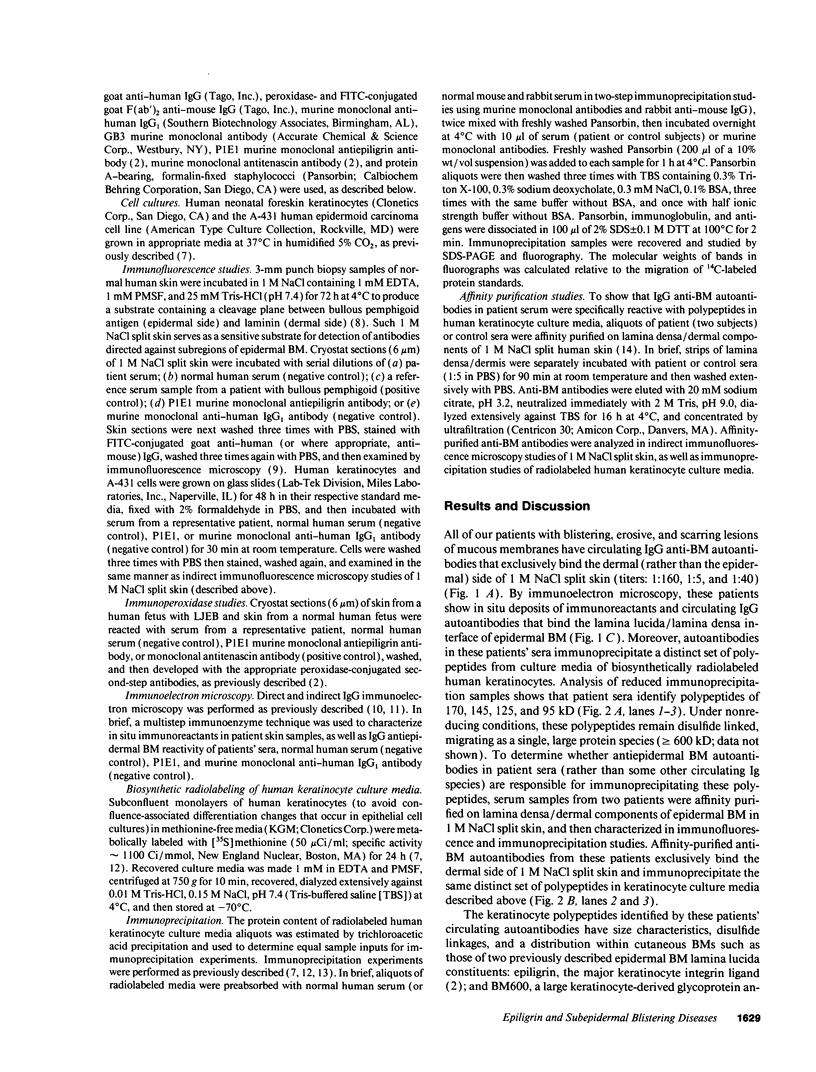
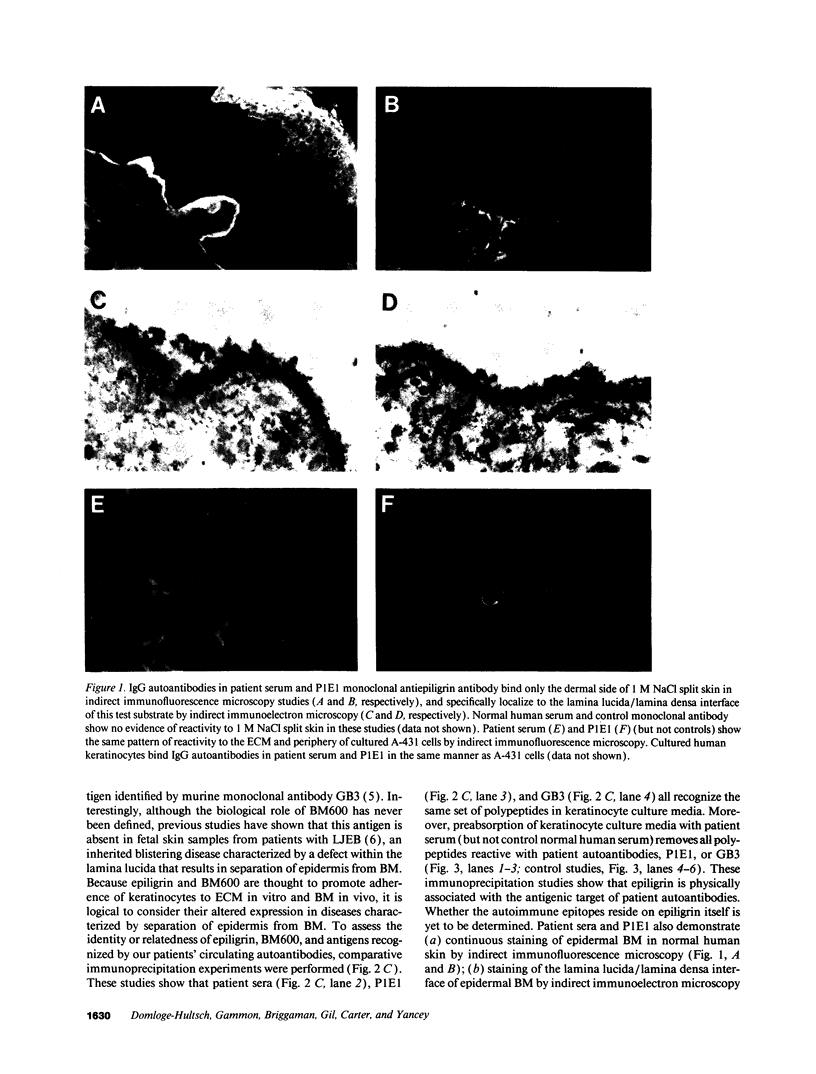
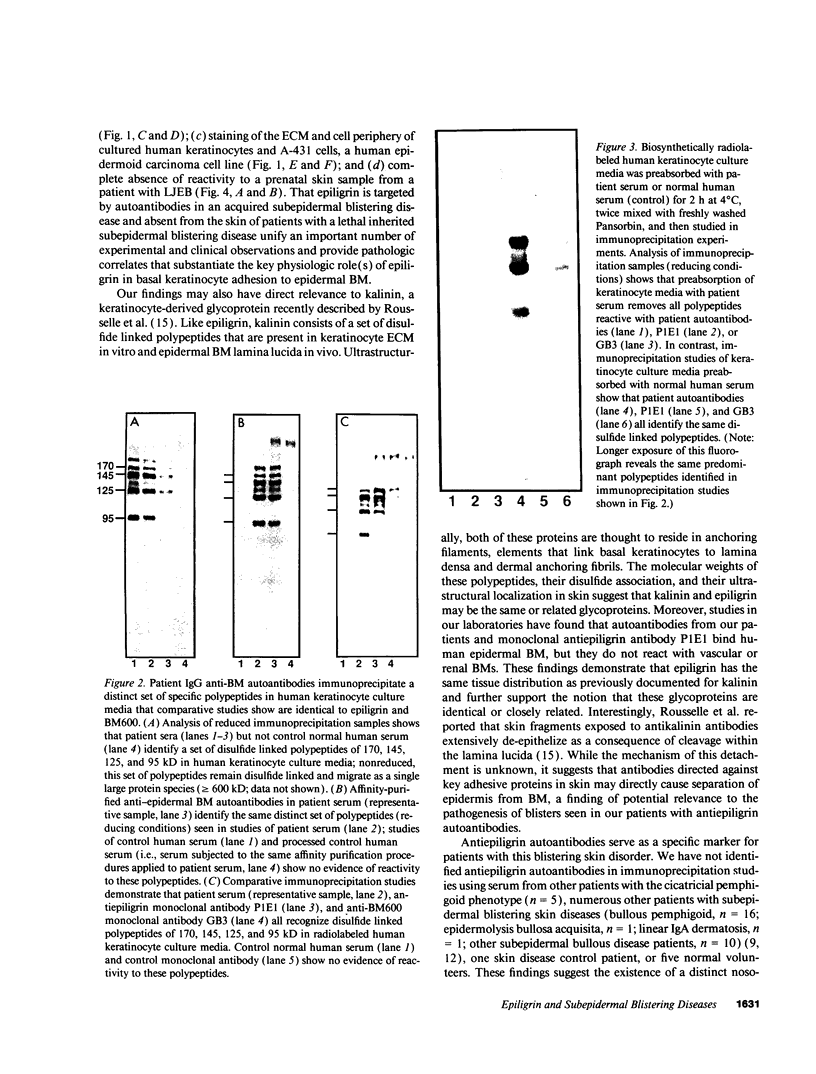
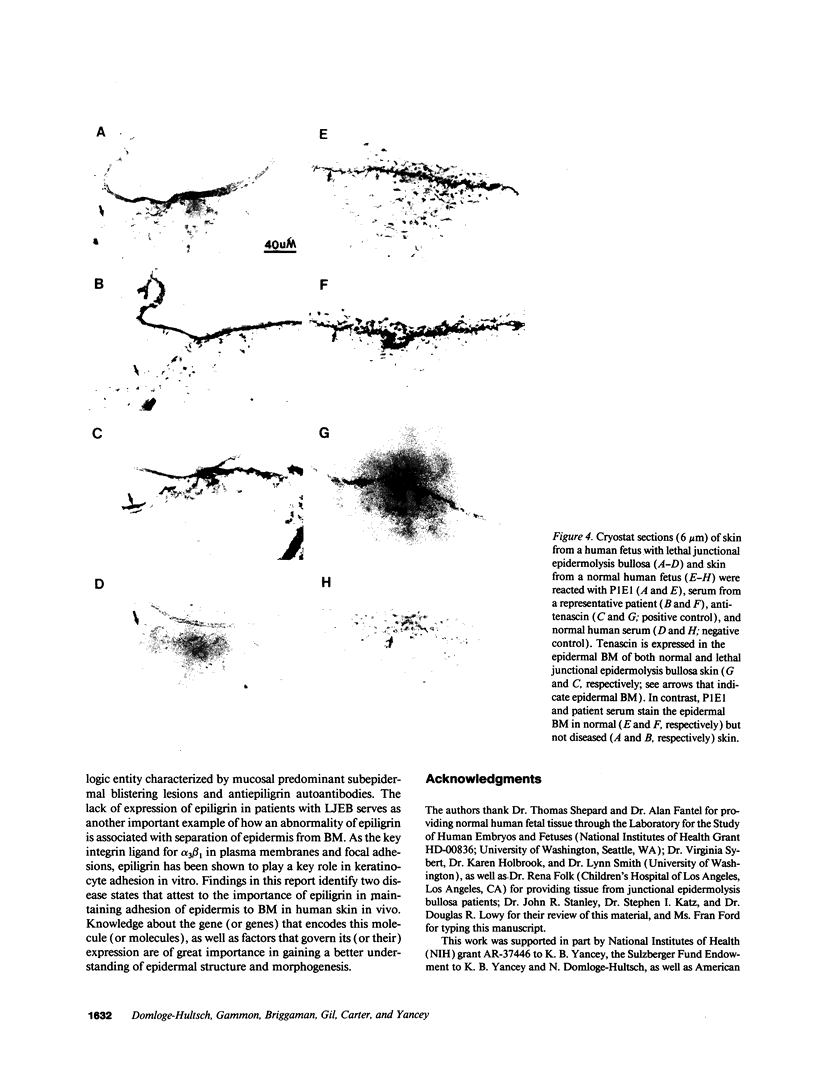
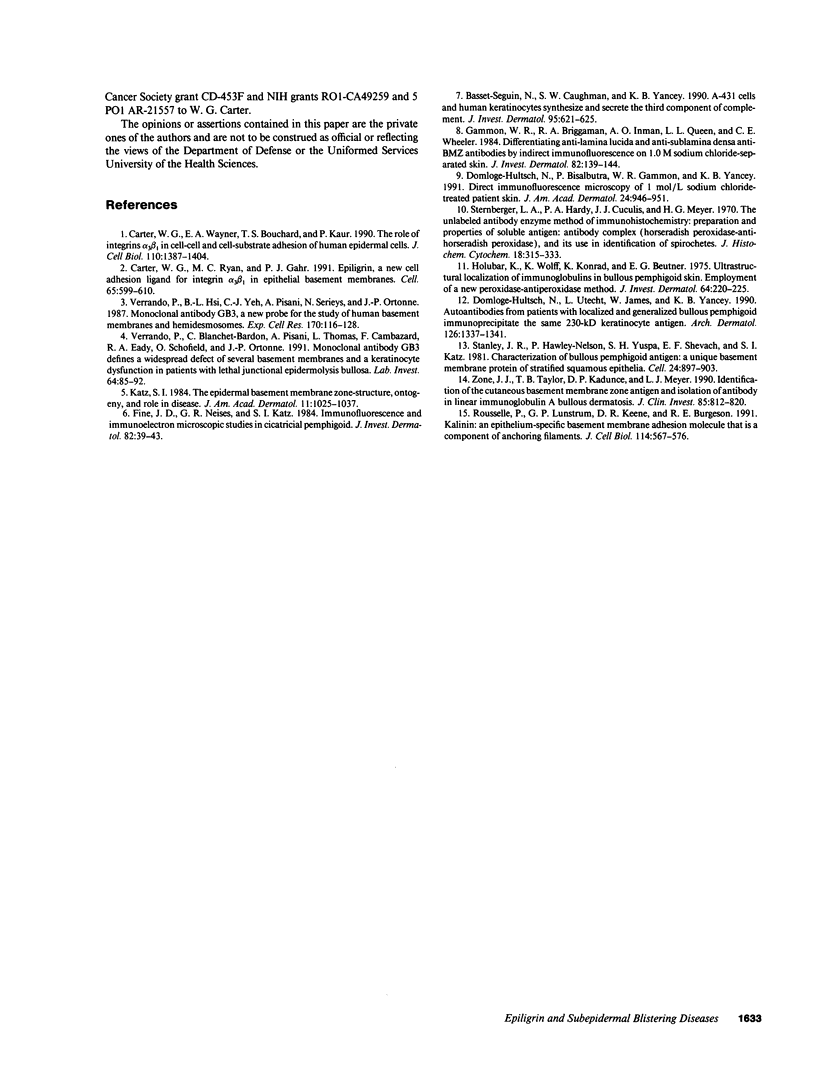
Images in this article
Selected References
These references are in PubMed. This may not be the complete list of references from this article.
- Basset-Séguin N., Caughman S. W., Yancey K. B. A-431 cells and human keratinocytes synthesize and secrete the third component of complement. J Invest Dermatol. 1990 Dec;95(6):621–625. doi: 10.1111/1523-1747.ep12513524. [DOI] [PubMed] [Google Scholar]
- Carter W. G., Ryan M. C., Gahr P. J. Epiligrin, a new cell adhesion ligand for integrin alpha 3 beta 1 in epithelial basement membranes. Cell. 1991 May 17;65(4):599–610. doi: 10.1016/0092-8674(91)90092-d. [DOI] [PubMed] [Google Scholar]
- Carter W. G., Wayner E. A., Bouchard T. S., Kaur P. The role of integrins alpha 2 beta 1 and alpha 3 beta 1 in cell-cell and cell-substrate adhesion of human epidermal cells. J Cell Biol. 1990 Apr;110(4):1387–1404. doi: 10.1083/jcb.110.4.1387. [DOI] [PMC free article] [PubMed] [Google Scholar]
- Domloge-Hultsch N., Bisalbutra P., Gammon W. R., Yancey K. B. Direct immunofluorescence microscopy of 1 mol/L sodium chloride-treated patient skin. J Am Acad Dermatol. 1991 Jun;24(6 Pt 1):946–951. doi: 10.1016/0190-9622(91)70151-q. [DOI] [PubMed] [Google Scholar]
- Domloge-Hultsch N., Utecht L., James W., Yancey K. B. Autoantibodies from patients with localized and generalized bullous pemphigoid immunoprecipitate the same 230-kd keratinocyte antigen. Arch Dermatol. 1990 Oct;126(10):1337–1341. [PubMed] [Google Scholar]
- Fine J. D., Neises G. R., Katz S. I. Immunofluorescence and immunoelectron microscopic studies in cicatricial pemphigoid. J Invest Dermatol. 1984 Jan;82(1):39–43. doi: 10.1111/1523-1747.ep12259075. [DOI] [PubMed] [Google Scholar]
- Gammon W. R., Briggaman R. A., Inman A. O., 3rd, Queen L. L., Wheeler C. E. Differentiating anti-lamina lucida and anti-sublamina densa anti-BMZ antibodies by indirect immunofluorescence on 1.0 M sodium chloride-separated skin. J Invest Dermatol. 1984 Feb;82(2):139–144. doi: 10.1111/1523-1747.ep12259692. [DOI] [PubMed] [Google Scholar]
- Holubar K., Wolff K., Konrad K., Beutner E. H. Ultrastructural localization of immunoglobulins in bullous pemphigoid skin. Employment of a new peroxidase-antiperoxidase multistep method. J Invest Dermatol. 1975 Apr;64(4):220–227. doi: 10.1111/1523-1747.ep12510658. [DOI] [PubMed] [Google Scholar]
- Katz S. I. The epidermal basement membrane zone--structure, ontogeny, and role in disease. J Am Acad Dermatol. 1984 Dec;11(6):1025–1037. doi: 10.1016/s0190-9622(84)80189-9. [DOI] [PubMed] [Google Scholar]
- Rousselle P., Lunstrum G. P., Keene D. R., Burgeson R. E. Kalinin: an epithelium-specific basement membrane adhesion molecule that is a component of anchoring filaments. J Cell Biol. 1991 Aug;114(3):567–576. doi: 10.1083/jcb.114.3.567. [DOI] [PMC free article] [PubMed] [Google Scholar]
- Stanley J. R., Hawley-Nelson P., Yuspa S. H., Shevach E. M., Katz S. I. Characterization of bullous pemphigoid antigen: a unique basement membrane protein of stratified squamous epithelia. Cell. 1981 Jun;24(3):897–903. doi: 10.1016/0092-8674(81)90115-x. [DOI] [PubMed] [Google Scholar]
- Sternberger L. A., Hardy P. H., Jr, Cuculis J. J., Meyer H. G. The unlabeled antibody enzyme method of immunohistochemistry: preparation and properties of soluble antigen-antibody complex (horseradish peroxidase-antihorseradish peroxidase) and its use in identification of spirochetes. J Histochem Cytochem. 1970 May;18(5):315–333. doi: 10.1177/18.5.315. [DOI] [PubMed] [Google Scholar]
- Verrando P., Blanchet-Bardon C., Pisani A., Thomas L., Cambazard F., Eady R. A., Schofield O., Ortonne J. P. Monoclonal antibody GB3 defines a widespread defect of several basement membranes and a keratinocyte dysfunction in patients with lethal junctional epidermolysis bullosa. Lab Invest. 1991 Jan;64(1):85–92. [PubMed] [Google Scholar]
- Verrando P., Hsi B. L., Yeh C. J., Pisani A., Serieys N., Ortonne J. P. Monoclonal antibody GB3, a new probe for the study of human basement membranes and hemidesmosomes. Exp Cell Res. 1987 May;170(1):116–128. doi: 10.1016/0014-4827(87)90121-2. [DOI] [PubMed] [Google Scholar]
- Zone J. J., Taylor T. B., Kadunce D. P., Meyer L. J. Identification of the cutaneous basement membrane zone antigen and isolation of antibody in linear immunoglobulin A bullous dermatosis. J Clin Invest. 1990 Mar;85(3):812–820. doi: 10.1172/JCI114508. [DOI] [PMC free article] [PubMed] [Google Scholar]









